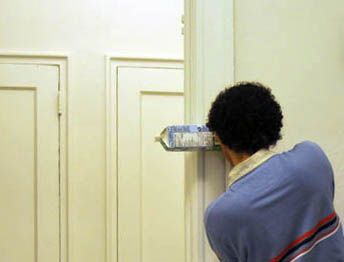|
Teach
With Bigshot |
See Around CornersNext
Prev
A periscope allows people to see around corners or peek above walls. Inside, a series of mirrors work together to guide light from one end of the periscope towards the viewer’s eye at the other end. Follow these directions to make a periscope of your own. Things You Need
Tall milk carton

Two 2" x 4" mirrors

Cardboard

Pen or pencil

Ruler

Scissors
(Touch or hover over each item for more information or alternatives)
How To Make ItThings To Try
Use the periscope to see around corners. You can hide behind a wall while looking through the peephole. Hold the periscope vertically to take a peek above tables or other furniture. How It WorksMirrors reflect light. When you look at a mirror, the view you see through it is the view that you would get if you were able to stand exactly where your reflection is on the other side of the mirror, except left becomes right and right becomes left. The mirror itself becomes a line of symmetry between your actual location and the virtual point of view that you see.  Since there are two mirrors in your periscope, light is reflected twice before it reaches your eye. The mirror next to the eyepiece changes your point of view from where your eye actually is to where its reflection is behind the mirror (here, the line of symmetry is the dotted blue line). The second mirror changes your virtual point of view from that first reflection to where its reflection would be (here, the line of symmetry is the dotted green line). Your final point of view is the view from that second reflection. Fun FactsPeriscopes of the DeepMost submarines have a periscope in order to allow the crew to see above the surface of the water. The periscope can usually be extended to a length of up to 60 feet, and can be swiveled to give the operator a 360 degree view of the ocean surface. The lowest depth at which a submarine can use a periscope is called the periscope depth. Fiber Optic CablesOptical fibers work in a similar way as your periscope. The fibers are thin strands of glass that are surrounded by a reflective glass coating that acts as a mirror. Signals of light are sent through one end bounce around inside the strand until they reach the other end. When light reflects off of a glass surface instead of passing through it, it is called total internal reflection. Fiber optic cables are rapidly replacing copper wires in many areas of communication. World's largest mirror mazeMirror mazes are a frequent sight at amusement parks and county fairs. Their floor-to-ceiling mirrors confuse guests by producing reflections that represent dozens upon dozens of points of view. Many guests give up on their eyes altogether and keep their hands forward to feel their way to the exit. The world’s largest mirror maze is located in Gatlinburg, Tennessee.

|
| [1] | N. Ardley, 101 great science experiments. DK Publishing, 2006 |
| [2] | "Periscope." Wikipedia, The Free Encyclopedia. [Online]. Available: http://en.wikipedia.org/wiki/Periscope. [Accessed: Jan 20, 2013]. |









 References
References